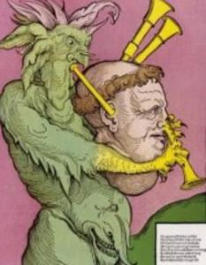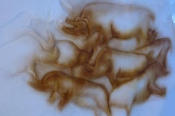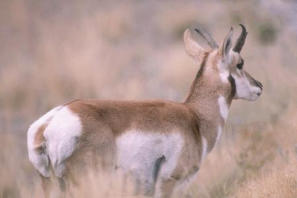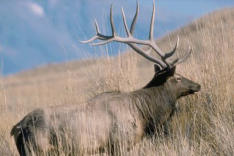

Infrasounds, Ghosts, Dead Mad Skiers, and Mankind’s Hunting Machines Frighten Animals: We humans rationalize
that animals have senses similar to our very limited ones. Think that as a hunter and you might as well stalk an inert
Abrams Tank rather than creatures which constantly depend on wariness. In this section we explore sounds never heard
by humans because we can hear them – although we too do respond to them. Animals senses are atoned to low and
high frequencies by the necessity of survival.
What are Infrasounds?: Infrasounds are those with frequencies below human hearing, from 20 Hertz down to 0.001Hz.
There are a number of human caused and natural sources. Wind turbines, diesel generation stations and highway traffic
are some common artificial noises. Natural infrasonic sounds may be caused by weather, sandstorms, winds, wildfires,
volcanoes, waterfalls, meteors, distant tornadoes, and upper atmosphere lightning. Infrasound researchers Bedard and
Georges (2000) suggest infrasonic power radiated from one strong, high altitude storm may be equivalent to the electric
consumption of a city of 100,000.
Infrasounds have very long wave lengths measured in meters. These waves travel faster along the ground in all directions
than sound traveling through air. That is because the ground is much more dense than air. Infrasounds travel global
distances with little loss of energy. Ten infraounds nuclear explosion detectors in the US and Canada measured the in-air
explosion of the space shuttle Columbia rocket off the coast of Florida. The Navy had an infrasoud transmission station
in Michigan to communicate with submarines around the world. These sound messages traveled along the salinity
isocline.
Infasounds travel along the terrain until they are projected by the topography into the sky where they dissipate in the
atmosphere. However, the energy can be refracted back to the ground by low, especially dense clouds. That is why the
sounds of traffic and train rumbling is more noticeable when there is a thick cloud cover. The quick elimination of high
frequency sounds in thunder storms is a good example of fequency absorbtion by air an humidity. The high frequency
crack of a distant lightning bolt is not heard, but the low frequency rumbling is heard a great distance away.
We live on the west side of Denver, about three miles from Interstate 70 and Highway 6. In the last forty years the vehicle
tire and turbulence noise have dramatically increased. The low level sound is best described as a constant low frequency
roar. It increases volume when there are low-level clouds. Local deer and elk may have become used to this noise, but I
think wilderness elk would be irritated. This infrasound commotion goes largely unnoticed because infrasound does not
travel far in the atmosphere, and we humans can not hear it. (But do we become nervous, irritable and fatigued from it?
Please read on.)
Observing animals respond to infrasound: We are fortunate to have a hunting
cabin on friends’ Wyoming ranch. There we hunt, loaf and admire the landscape
and can closely observe animals. One summer morning I was traipsing the terrain
to get in shape for hunting season. All of a sudden antelope around the landscape
stood up and began anxiously moving to the northeast. I changed directions to
the southwest to see what was the threat. In two miles I began to “comprehend”
an intermittent barely audible low-frequency humming sound. Topping a ridge, I
saw a road crew another two miles away using a vibrator to “thump” the 6X6-inch
guardrail posts into the ground. When morning roadwork commenced, an
infrasound was created. These low noise and perhaps even local seismic ground
vibration were the cause of the antelope rising from beds and stopeing off. This observation convinced me that animals
strongly react to infrasounds NEWLY projected into their territorial comfort zones.
Machine infrasounds affected hunting: Generators ordinarily can be a nuisance for hunting. One year a group of elk
hunters brought a mega-generator to the beginning of Meadows Valley which adjoins and penetrates into the wilderness.
The generator ran from dusk to morning. It had a faulty regulator that made the engine sound rise and fall, and an
undersized or decrepit muffler. The Meadows is a broad valley which narrows and curves in its upper reach where it has
ravines at its head. The generator engine noise reverberated up and down the horn-shaped valley and draws. This
caused an eerie very low frequency rising and falling moan that permeated the wilderness. Evidently the elk did not
appreciate the constant Didgeridoo-like moaning when the echoes intersected. Successful elk hunters had to beat the
timber that year because elk hid there until dark. The deer and elk were scarce. Those that remained were spooked and
rarely came out at dusk and dawn as they usually do. Come prepared to use a gas stove and lanterns so that you have
better chances of scoring a big bull!
Animal Infrasound Communnication: Animals communicate or analyze their surroundings using infrasounds.
Rhinoceros, giraffes, and alligators are known to communicate long distances with sub-human-hearing voices. K.Payne’s
research (Silent Thunder, 1988) discloses elephants use infrasounds to communicate long distances. Whales can
exchange information over a hundred miles, and some whale pods communicate between oceans. Owls use sounds to
locate prey in the dark, and of course there is the robin which analyzes sounds of slowly crawling earthworms to make a
precision subsoil strike. On the prehistoric side, some dinosaurs have huge nasal cavities whose apparent function is to
generate and amplify infrasounds.
Elk and Red Deer have unusual vocalizations. They are the only mammals who have a
larynx (voice box) down the throat (as do humans). This allows them to create deeper,
more threatening vocalizations when they stretch their necks as they thrust their heads
forward. Red Deer can do a lot better. Their larynx can flex far down (even into the upper
chest) to emit a very bass sound when they want to threaten a rival. Part of the emitted
sound is in the ultra-low, anxiety-producing infrasound range. Low pitch sounds are
threatening. A low, slow growl communicates to the opponent that it had better think
again. Consider the slow, dropped pitch voice of an angry executive’s short phrase. You instinctively get the message to
straighten up and not repeat the perceived error.
Infrasounds affect people. They disrupt sleep patterns, activate glandular activity, and generally agitate individuals.
They may even induce fear and irrational behavior. United Kingdom researcher Richard Wiseman (2007) and colleagues
presented two identical concerts. Unknown to the attendees, one concert included an infrasound in the 17Hz range.
Twenty two percent of the people listening to this concert reported anxiety, sorrow, uneasiness, feelings of fear and
revulsion, spine tingles and chest pressure. The people were affected by the phantom frequencies even though they
could not consciously hear the infrasounds.
Robert Claveriny (1779) noticed that winds howling down/across chimneys produced gloomy effects in house occupants. I
mention here as an aside that several cultures in cold climates of Tuva, Siberia, Mongolia, Tibet and the American Arctic
are throat singers. They modulate a low pitch drone and simultaneously overlay a high pitch melody. It is as if they are
relating to and trying to communicate with long cold, windy winter conditions. Or (?), is this ability passed down from
prehistoric hunters who used the drone to lure animals closer; e.g., a seal to a vent hole? From experience I know that
animals are curious to low volume, abnormal tones, whispering, and clicks. I had a doe deer
walk up to me as I was tuning my autoharp while sitting in the woods.
1746 War Weapons Strike Fear in Loyalists, and Executing a Poor Scott The earliest
bagpipes were probably developed in the 12-1300s. The bagpipe was an instrument of the
devil, as illustrated by artist Erhard Shoen (Cir 1530). Its drones created fear, loathing and
apprehension of evil forebodings with their irritating sounds. The church used variations of
Shoen’s depiction in its attempt to avert fracturing of the Catholic Church. (The lower right
hand square was left blank by the poster printers so that proclamations could be inserted by
local clerics.)
In 1314 bagpipes played at the Battle of Banockburn, Scotland, stimulated the highlanders to
decisive victory. Those pipes had only a single drone, but this drone was probably a longer,
larger one that emitted a lower frequency pulsating sounds. Highland chiefs quickly
recognized the usefulness of pipe music in inciting ferocious fighting. The English troops
were frightened by the distant droning music long before the Scotsmen were even seen. Their anxiety prematurely
drained their adrenalin and battle enthusiasm hours before the battle engagement.
In 1745 Loyalists had enough of this fright and officially classified the bagpipe as an instrument of war used by the
supporters of Bonnie Prince Charlie. No one could possess a pipe under the penalty of death. Pipes were destroyed, and
those not found went into long-term hiding. In 1746 the simple, non-warrior piper James Reid was found with a bagpipe,
charged with treason, and executed.
I theorize bagpipe sub-human-hearing infrasounds caused unconscious fear in the British soldiers. The low frequency
sounds of a large bagpipe band probably reverberated over the Scottish hills like a subtle, at first unnoticed but
prophesying distant thunder of what was to come..
Other writers have theorized that the simple amplitude of bagpipe bands instilled fear in troops, and also the thought
that there were many more Scotsmen than there actually were. Bagpipe bands continues to instill excitement in troops
and parades around the world. So how loud are bagpipes? In Discord:The Story Of Noise, Goldsmith (2012) exposes a
2006 Scotland Medical Directorate based on a study of acoustical volumes of bagpipes played by soldiers learning to play
the pipes. Measurements were made of a practice session indoors and outdoors. Indoors the volume reached 111 dB
(pneumatic hammer level), and outdoors 116 dB (chainsaw level). The formulated regulations specified that an ear-
plugged soldier may practice only 15 minutes a day indoors, or 24 minutes a day outdoors. You can imagine it will take
the fellows a long time to learn to play the pipes!
Infrasound has been investigated by military scientist for many years. Loudspeakers were used to harass the enemy, and
bass rock music to breakdown terrorist resistance to interrogation. However, no one has yet perfected infrasound gun.
HIgh energy sound in the 1-3 mHz range can liquefy flesh.
Infrasound May Even Indirectly Kill People. An example is the mysterious actions of nine
experienced backcountry Siberian skiers on Dyatlov Pass. They evidently were mentally overcome by
wind-created infrasound as they slept in their tents. Each person bolted out of holes cut in the tent
partially clothed, shoeless, in socks, and near naked. They ran panicked in different directions. They did
not regroup. The little clothing they wore was subsequently shed, indicating they did not regain mental
functionality until they entered hypothermia and succumbed to the cold.
Author-researcher D. Eichar (2014) believes a rare storm phenomonom called a Karman Vortex Street
could have produced terrifying auditory and infrasounds proven to produce fear in humans. It is his
theory that straight-line winds encountered a blunt topographic obstacle; in this case the high dome shaped Dead
Mountain. The wind parted around and over the obstacle mountain and reformed on the other side in multiple circular
vortices. The jumble of mini-tornadic vortices spun at a different speeds (and therefore noise frequency) as they
harmonically vibrated together. Each of these vortices would have emitted ultra and more importantly terrifying
infrasounds. The combined sounds would probably wailed and sounded multi-harmonic and terrifying. The result was a
sustained low frequency calliope-like moaning and terrifying noise.
Eichar believes the skiers became claustrophobic in the black tent when the first sub-hearing drones of the approaching
vortexes agitated their psyche. The sounds became more intense and mental dread became unbearable as the wind
speed increased. The hikers individually panicked as the multiple vortexes’ infrasounds surrounded them – they simply
went start raving mad.
Karmen Vortex Street can be seen in nature. This 1999 Landsat 7 photo shows
the vortices created by windblown clouds streaming around the Juan Fernandez
(aka Robinson Crusoe) Islands off the Chilean coast.
Note: you can experiment with obstacle turbulence. Place a blunt object in front
of a candle and give a sharp puff straight at that object. Turbulence created
behind the candle will snuff out the flame and the smoke will swirl in Karmen
Vortex Street eddies. The smoke eddies will give you an idea of why an entire
English power station was shaken down and burned when one smoke tower
created intense vibrations which toppled down-wind towers.
Spooks in Castles and Hollows: Some English castles have open windows which
allow wind to enter and resonate low frequency sounds which create eerie feeling in visiting tourists. Other castles
catering to tourists use infrasouds to create the illusions of ghostly atmospheres. They purposely place wires or metallic
ribbons across windows to make low frequency noises which intermittently reverberate through castle halls.
Vic Tandy and psychologist Tony Lawrence (1998) suggest an infrasonic sound in about the 19Hz range can give humans
an anxious feeling they are being watched. This can occur best if the room size is in multiples of the sound wave length.
This creates standing waves which can multiply the sound energy, even to the level of making objects vibrate in
resonance. He even postulates that at 18.98Hz (optimum for his laboratory size) he saw a gray blob (what others might
call a ghost) because his eye ball quivered. Thus, haunted sites may just be the location of infrasounds.
Cave Ghosts and Cave Paintings Locations Placed by Infrasounds. Archaeologists theorize
that certain locations in sacred caves are infrasound compounding points where natural cave
noises intersect. This is where the presence of “spirits” can be subliminally felt - where a
person gets that creepy, someone is watching you feeling. Passage locations where th
ere are these certain strange supernatural feelings are where many Paleolithic shamen
painted cave wall murals or other sacred symbols. They could hear the spirits of the painted
bison, elk, bear and horses. They may have believed they could spiritually communicate with the animals.
Could Medicine Men and Shamen Sense Near and Distant Game? In my book I stress the need to communicate with
nature through many senses. I have to wonder if extensive, usually lifetime training of these specially chosen alert
children tuned them to simply sense distant conditions. They used not only their own senses, but innately
comprehended the nuances of small animal reactions to distant changing conditions which produced infrasounds. The
birds and animals sensed the infrasound warnings directly, while the shamen, unable to hear these low frequencies
sensed them indirectly though the responses of all living things. This was part of the shamens’ “sixth sense” repertoire.
Infrasound is Known to Affect Animal Behaviors. Livestock, ravens, snakes and all sorts of animals became agitated
and panicked well before Dust Bowl era sandstorms appeared. Roaring prairie wild fires also spooked livestock well
before the fire and smoke were observed. S. Miles (2015) reviews a bird tracking study by Henry Streby of the U.
California/Berkley. Golden-winged warblers were fitted with devices to track their migrations. Five birds returned to their
Tennessee breeding ground, but mysteriously immediately left and made excursions of up to 1,500 km to avoid tornadic
storms that subsequently devastated SE United States in April, 2013. One bird even fled to Cuba for a sojourn. The
researchers concluded infrasounds from the distant tornadoes tipped the birds off that storms were approaching.
Like animals, humans unconsciously react to infrasounds. Early isolated, lonely homesteaders sometimes succumbed to
winds and went crazy (Anemophobia) because of winds whipped prairies. Down-slope Chinook and Foehn winds have
long been associated with increased suicides throughout the world.
Does Game Respond to Infrasound? I have no doubt that game is agitated by unusual infrasounds. I think multiple ATVs
traveling and (particularly) streaking down a road will create sound waves from exhaust, engine whine and tire vibrations.
Multiple sound sources traveling at different speeds also create sound wave frequency interference sounds. Infrasounds
travel along the ground and alert animals to be on guard. These sounds echo off terrain until high energy is absorbed by
vegetation and soil. The residual, very long wavelength energy permeates the country with a dull hum mostly unheard by
us humans. You have probably heard jet plane noise reverberate in the mountains, and it is reasonable to believe the
vehicle and motor noise and echo vibrations create far-traveling infrasounds. These low rumbling infrasounds agitate
animals if they are not accustomed or conditioned to them by long-term exposure. Conditioning may perhaps begin even
before birth as it does in humans. However, wilderness animals are not exposed to this noise all year long, so ATV
produced infrasound forebodes seasonal alarm. Note: In my book you can review the research results of relative alarm
distances from various back-country activities.
Game Disorientation: It is harder to determine (acoustically triangulate) the source of low frequency
sounds than high frequency sounds. Infrasounds are even harder to pinpoint. The inability to quickly
determine a sound source confuses an already alerted animal, and this uncertainty elevates fear. This is the
seventh sense of animals. Flight will probably occur spontaneously, or as soon as asecondary trigger sense
is activated. At the least, the sound felt by animals will put them in heightened alertness. Some bow hunters
in the final stages of a stalk remove their boots and change into thick wool socks to avoid creating boot-fall
ground vibrations. They stalk “Indian style”. In my book I review potential animal and human caused seismic
ground vibrations we would listened to, especially on frozen ground mornings. A lot of information about
hunter and animal movement can be gathered by simply listening to the ground!






Infrasounds and
Animal Behavior

© 2014-2021 Copyright by P. K. H. Groth, Denver, Colorado, USA All rights reserved - See contact page for for permission to republish article
excerpts.




- Hunter welfare
- Hunter poster child
- Altitude sickness
- Hunter heart attacks
- Hunter heart stress
- Altitude sleep problems
- Hunter spine/bone damage
- Back country hazards
- Man made hazards
- Hunter bear attacks
- Bear problems
- Mtn lion Awareness
- Insect problems and diseases
- Hunt camp rodent problems
- Game meat dangers
- Elk meat diseases


Infrasounds, Ghosts, Dead Mad Skiers, and Mankind’s
Hunting Machines Frighten Animals: We humans
rationalize that animals have senses similar to our very
limited ones. Think that as a hunter and you might as well
stalk an inert Abrams Tank rather than creatures which
constantly depend on wariness. In this section we explore
sounds never heard by humans because we can hear them
– although we too do respond to them. Animals senses are
atoned to low and high frequencies by the necessity of
survival.
What are Infrasounds?: Infrasounds are those with
frequencies below human hearing, from 20 Hertz down to
0.001Hz. There are a number of human caused and
natural sources. Wind turbines, diesel generation stations
and highway traffic are some common artificial noises.
Natural infrasonic sounds may be caused by weather,
sandstorms, winds, wildfires, volcanoes, waterfalls,
meteors, distant tornadoes, and upper atmosphere
lightning. Infrasound researchers Bedard and Georges
(2000) suggest infrasonic power radiated from one strong,
high altitude storm may be equivalent to the electric
consumption of a city of 100,000.
Infrasounds have very long wave lengths measured in
meters. These waves travel faster along the ground in all
directions than sound traveling through air. That is
because the ground is much more dense than air.
Infrasounds travel global distances with little loss of
energy. Ten infraounds nuclear explosion detectors in the
US and Canada measured the in-air explosion of the space
shuttle Columbia rocket off the coast of Florida. The Navy
had an infrasoud transmission station in Michigan to
communicate with submarines around the world. These
sound messages traveled along the salinity isocline.
Infasounds travel along the terrain until they are projected
by the topography into the sky where they dissipate in the
atmosphere. However, the energy can be refracted back to
the ground by low, especially dense clouds. That is why the
sounds of traffic and train rumbling is more noticeable
when there is a thick cloud cover. The quick elimination of
high frequency sounds in thunder storms is a good
example of fequency absorbtion by air an humidity. The
high frequency crack of a distant lightning bolt is not
heard, but the low frequency rumbling is heard a great
distance away.
We live on the west side of Denver, about three miles from
Interstate 70 and Highway 6. In the last forty years the
vehicle tire and turbulence noise have dramatically
increased. The low level sound is best described as a
constant low frequency roar. It increases volume when
there are low-level clouds. Local deer and elk may have
become used to this noise, but I think wilderness elk would
be irritated. This infrasound commotion goes largely
unnoticed because infrasound does not travel far in the
atmosphere, and we humans can not hear it. (But do we
become nervous, irritable and fatigued from it? Please
read on.)
Observing animals respond to
infrasound: We are fortunate to have a
hunting cabin on friends’ Wyoming
ranch. There we hunt, loaf and admire
the landscape and can closely observe animals. One
summer morning I was traipsing the terrain to get in shape
for hunting season. All of a sudden antelope around the
landscape stood up and began anxiously moving to the
northeast. I changed directions to the southwest to see
what was the threat. In two miles I began to “comprehend”
an intermittent barely audible low-frequency humming
sound. Topping a ridge, I saw a road crew another two
miles away using a vibrator to “thump” the 6X6-inch
guardrail posts into the ground. When morning roadwork
commenced, an infrasound was created. These low noise
and perhaps even local seismic ground vibration were the
cause of the antelope rising from beds and stopeing off.
This observation convinced me that animals strongly react
to infrasounds NEWLY projected into their territorial
comfort zones.
Machine infrasounds affected hunting: Generators
ordinarily can be a nuisance for hunting. One year a group
of elk hunters brought a mega-generator to the beginning
of Meadows Valley which adjoins and penetrates into the
wilderness. The generator ran from dusk to morning. It
had a faulty regulator that made the engine sound rise and
fall, and an undersized or decrepit muffler. The Meadows
is a broad valley which narrows and curves in its upper
reach where it has ravines at its head. The generator
engine noise reverberated up and down the horn-shaped
valley and draws. This caused an eerie very low frequency
rising and falling moan that permeated the wilderness.
Evidently the elk did not appreciate the constant
Didgeridoo-like moaning when the echoes intersected.
Successful elk hunters had to beat the timber that year
because elk hid there until dark. The deer and elk were
scarce. Those that remained were spooked and rarely
came out at dusk and dawn as they usually do. Come
prepared to use a gas stove and lanterns so that you have
better chances of scoring a big bull!
Animal Infrasound Communnication: Animals
communicate or analyze their surroundings using
infrasounds. Rhinoceros, giraffes, and alligators are known
to communicate long distances with sub-human-hearing
voices. K.Payne’s research (Silent Thunder, 1988) discloses
elephants use infrasounds to communicate long distances.
Whales can exchange information over a hundred miles,
and some whale pods communicate between oceans. Owls
use sounds to locate prey in the dark, and of course there
is the robin which analyzes sounds of slowly crawling
earthworms to make a precision subsoil strike. On the
prehistoric side, some dinosaurs have huge nasal cavities
whose apparent function is to generate and amplify
infrasounds.
Elk and Red Deer have
unusual vocalizations. They
are the only mammals who
have a larynx (voice box)
down the throat (as do
humans). This allows them to
create deeper, more
threatening vocalizations
when they stretch their necks as they thrust their heads
forward. Red Deer can do a lot better. Their larynx can flex
far down (even into the upper chest) to emit a very bass
sound when they want to threaten a rival. Part of the
emitted sound is in the ultra-low, anxiety-producing
infrasound range. Low pitch sounds are threatening. A low,
slow growl communicates to the opponent that it had
better think again. Consider the slow, dropped pitch voice
of an angry executive’s short phrase. You instinctively get
the message to straighten up and not repeat the perceived
error.
Infrasounds affect people. They disrupt sleep patterns,
activate glandular activity, and generally agitate
individuals. They may even induce fear and irrational
behavior. United Kingdom researcher Richard Wiseman
(2007) and colleagues presented two identical concerts.
Unknown to the attendees, one concert included an
infrasound in the 17Hz range. Twenty two percent of the
people listening to this concert reported anxiety, sorrow,
uneasiness, feelings of fear and revulsion, spine tingles
and chest pressure. The people were affected by the
phantom frequencies even though they could not
consciously hear the infrasounds.
Robert Claveriny (1779) noticed that winds howling
down/across chimneys produced gloomy effects in house
occupants. I mention here as an aside that several
cultures in cold climates of Tuva, Siberia, Mongolia, Tibet
and the American Arctic are throat singers. They modulate
a low pitch drone and simultaneously overlay a high pitch
melody. It is as if they are relating to and trying to
communicate with long cold, windy winter conditions. Or
(?), is this ability passed down from prehistoric hunters
who used the drone to lure animals closer; e.g., a seal to a
vent hole? From experience I know that animals are
curious to low volume, abnormal tones, whispering, and
clicks. I had a doe deer walk up to me as I was tuning my
autoharp while sitting in the woods.
1746 War Weapons Strike Fear in Loyalists,
and Executing a Poor Scott The earliest
bagpipes were probably developed in the 12-
1300s. The bagpipe was an instrument of the
devil, as illustrated by artist Erhard Shoen (Cir
1530). Its drones created fear, loathing and
apprehension of evil forebodings with their irritating
sounds. The church used variations of Shoen’s depiction in
its attempt to avert fracturing of the Catholic Church. (The
lower right hand square was left blank by the poster
printers so that proclamations could be inserted by local
clerics.)
In 1314 bagpipes played at the Battle of Banockburn,
Scotland, stimulated the highlanders to decisive victory.
Those pipes had only a single drone, but this drone was
probably a longer, larger one that emitted a lower
frequency pulsating sounds. Highland chiefs quickly
recognized the usefulness of pipe music in inciting
ferocious fighting. The English troops were frightened by
the distant droning music long before the Scotsmen were
even seen. Their anxiety prematurely drained their
adrenalin and battle enthusiasm hours before the battle
engagement.
In 1745 Loyalists had enough of this fright and officially
classified the bagpipe as an instrument of war used by the
supporters of Bonnie Prince Charlie. No one could possess
a pipe under the penalty of death. Pipes were destroyed,
and those not found went into long-term hiding. In 1746
the simple, non-warrior piper James Reid was found with a
bagpipe, charged with treason, and executed.
I theorize bagpipe sub-human-hearing infrasounds caused
unconscious fear in the British soldiers. The low frequency
sounds of a large bagpipe band probably reverberated
over the Scottish hills like a subtle, at first unnoticed but
prophesying distant thunder of what was to come..
Other writers have theorized that the simple amplitude of
bagpipe bands instilled fear in troops, and also the
thought that there were many more Scotsmen than there
actually were. Bagpipe bands continues to instill
excitement in troops and parades around the world. So
how loud are bagpipes? In Discord:The Story Of Noise,
Goldsmith (2012) exposes a 2006 Scotland Medical
Directorate based on a study of acoustical volumes of
bagpipes played by soldiers learning to play the pipes.
Measurements were made of a practice session indoors
and outdoors. Indoors the volume reached 111 dB
(pneumatic hammer level), and outdoors 116 dB (chainsaw
level). The formulated regulations specified that an ear-
plugged soldier may practice only 15 minutes a day
indoors, or 24 minutes a day outdoors. You can imagine it
will take the fellows a long time to learn to play the pipes!
Infrasound has been investigated by military scientist for
many years. Loudspeakers were used to harass the enemy,
and bass rock music to breakdown terrorist resistance to
interrogation. However, no one has yet perfected
infrasound gun. HIgh energy sound in the 1-3 mHz range
can liquefy flesh.
Infrasound May Even Indirectly Kill People.
An example is the mysterious actions of nine
experienced backcountry Siberian skiers on
Dyatlov Pass. They evidently were mentally
overcome by wind-created infrasound as they
slept in their tents. Each person bolted out of
holes cut in the tent partially clothed,
shoeless, in socks, and near naked. They ran panicked in
different directions. They did not regroup. The little
clothing they wore was subsequently shed, indicating they
did not regain mental functionality until they entered
hypothermia and succumbed to the cold.
Author-researcher D. Eichar (2014) believes a rare storm
phenomonom called a Karman Vortex Street could have
produced terrifying auditory and infrasounds proven to
produce fear in humans. It is his theory that straight-line
winds encountered a blunt topographic obstacle; in this
case the high dome shaped Dead Mountain. The wind
parted around and over the obstacle mountain and
reformed on the other side in multiple circular vortices.
The jumble of mini-tornadic vortices spun at a different
speeds (and therefore noise frequency) as they
harmonically vibrated together. Each of these vortices
would have emitted ultra and more importantly terrifying
infrasounds. The combined sounds would probably wailed
and sounded multi-harmonic and terrifying. The result was
a sustained low frequency calliope-like moaning and
terrifying noise.
Eichar believes the skiers became claustrophobic in the
black tent when the first sub-hearing drones of the
approaching vortexes agitated their psyche. The sounds
became more intense and mental dread became
unbearable as the wind speed increased. The hikers
individually panicked as the multiple vortexes’ infrasounds
surrounded them – they simply went start raving mad.
Karmen Vortex Street can be seen in
nature. This 1999 Landsat 7 photo
shows the vortices created by
windblown clouds streaming around
the Juan Fernandez (aka Robinson
Crusoe) Islands off the Chilean coast.
Note: you can experiment with obstacle turbulence. Place
a blunt object in front of a candle and give a sharp puff
straight at that object. Turbulence created behind the
candle will snuff out the flame and the smoke will swirl in
Karmen Vortex Street eddies. The smoke eddies will give
you an idea of why an entire English power station was
shaken down and burned when one smoke tower created
intense vibrations which toppled down-wind towers.
Spooks in Castles and Hollows: Some English castles
have open windows which allow wind to enter and
resonate low frequency sounds which create eerie feeling
in visiting tourists. Other castles catering to tourists use
infrasouds to create the illusions of ghostly atmospheres.
They purposely place wires or metallic ribbons across
windows to make low frequency noises which
intermittently reverberate through castle halls.
Vic Tandy and psychologist Tony Lawrence (1998) suggest
an infrasonic sound in about the 19Hz range can give
humans an anxious feeling they are being watched. This
can occur best if the room size is in multiples of the sound
wave length. This creates standing waves which can
multiply the sound energy, even to the level of making
objects vibrate in resonance. He even postulates that at
18.98Hz (optimum for his laboratory size) he saw a gray
blob (what others might call a ghost) because his eye ball
quivered. Thus, haunted sites may just be the location of
infrasounds.
Cave Ghosts and Cave Paintings Locations Placed by
Infrasounds. Archaeologists
theorize that certain locations in
sacred caves are infrasound
compounding points where natural
cave noises intersect. This is where
the presence of “spirits” can be
subliminally felt - where a person
gets that creepy, someone is watching you feeling. Passage
locations where th
ere are these certain strange supernatural feelings are
where many Paleolithic shamen painted cave wall murals
or other sacred symbols. They could hear the spirits of the
painted bison, elk, bear and horses. They may have
believed they could spiritually communicate with the
animals.
Could Medicine Men and Shamen Sense Near and
Distant Game? In my book I stress the need to
communicate with nature through many senses. I have to
wonder if extensive, usually lifetime training of these
specially chosen alert children tuned them to simply sense
distant conditions. They used not only their own senses,
but innately comprehended the nuances of small animal
reactions to distant changing conditions which produced
infrasounds. The birds and animals sensed the infrasound
warnings directly, while the shamen, unable to hear these
low frequencies sensed them indirectly though the
responses of all living things. This was part of the shamens’
“sixth sense” repertoire.
Infrasound is Known to Affect Animal Behaviors.
Livestock, ravens, snakes and all sorts of animals became
agitated and panicked well before Dust Bowl era
sandstorms appeared. Roaring prairie wild fires also
spooked livestock well before the fire and smoke were
observed. S. Miles (2015) reviews a bird tracking study by
Henry Streby of the U. California/Berkley. Golden-winged
warblers were fitted with devices to track their migrations.
Five birds returned to their Tennessee breeding ground,
but mysteriously immediately left and made excursions of
up to 1,500 km to avoid tornadic storms that subsequently
devastated SE United States in April, 2013. One bird even
fled to Cuba for a sojourn. The researchers concluded
infrasounds from the distant tornadoes tipped the birds
off that storms were approaching.
Like animals, humans unconsciously react to infrasounds.
Early isolated, lonely homesteaders sometimes
succumbed to winds and went crazy (Anemophobia)
because of winds whipped prairies. Down-slope Chinook
and Foehn winds have long been associated with
increased suicides throughout the world.
Does Game Respond to Infrasound? I have no doubt that
game is agitated by unusual infrasounds. I think multiple
ATVs traveling and (particularly) streaking down a road will
create sound waves from exhaust, engine whine and tire
vibrations. Multiple sound sources traveling at different
speeds also create sound wave frequency interference
sounds. Infrasounds travel along the ground and alert
animals to be on guard. These sounds echo off terrain until
high energy is absorbed by vegetation and soil. The
residual, very long wavelength energy permeates the
country with a dull hum mostly unheard by us humans.
You have probably heard jet plane noise reverberate in the
mountains, and it is reasonable to believe the vehicle and
motor noise and echo vibrations create far-traveling
infrasounds. These low rumbling infrasounds agitate
animals if they are not accustomed or conditioned to them
by long-term exposure. Conditioning may perhaps begin
even before birth as it does in humans. However,
wilderness animals are not exposed to this noise all year
long, so ATV produced infrasound forebodes seasonal
alarm. Note: In my book you can review the research
results of relative alarm distances from various back-
country activities.
Game Disorientation: It is harder to determine
(acoustically triangulate) the source of low
frequency sounds than high frequency sounds.
Infrasounds are even harder to pinpoint. The
inability to quickly determine a sound source
confuses an already alerted animal, and this
uncertainty elevates fear. This is the seventh sense
of animals. Flight will probably occur spontaneously,
or as soon as asecondary trigger sense is activated.
At the least, the sound felt by animals will put them
in heightened alertness. Some bow hunters in the
final stages of a stalk remove their boots and
change into thick wool socks to avoid creating boot-
fall ground vibrations. They stalk “Indian style”. In my
book I review potential animal and human caused
seismic ground vibrations we would listened to,
especially on frozen ground mornings. A lot of
information about hunter and animal movement
can be gathered by simply listening to the ground!






Infrasounds and
Animal Behavior

© 2016 Copyright by P. K. H. Groth, Denver, Colorado, USA All rights reserved - See
contact page for for permission to republish article excerpts.


- Hunter welfare
- Hunter poster child
- Altitude sicknesses
- Hunter heart attack
- Hunter heart stress
- Altitude sleep problems
- Hunter spine and bone injuries
- Back country hazards
- Man caused hazards
- Bear attacks
- Bear camp problems
- Mountain. lion awareness
- Insect diseases and problems
- Camp rodent problems
- Game meat dangers
- Elk diseases

























